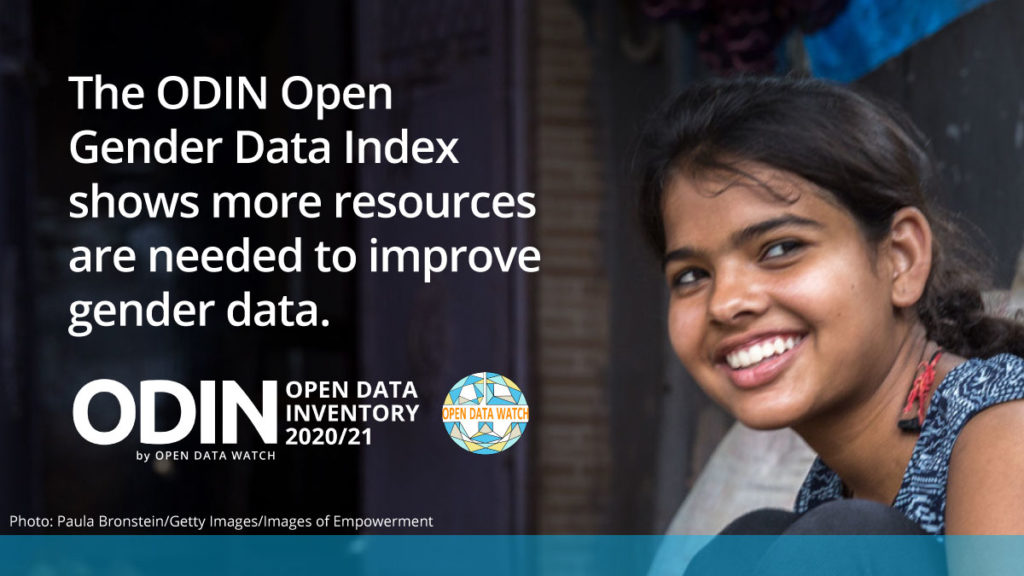As the world waits for the distribution of a vaccine and treatment options, there is a tool in our arsenal to strengthen our COVID-19 response: open data.
Open data allows for the widespread availability of data that everyone can use and republish as they wish, without restrictions from charges, copyright, or other mechanisms of control. Such data can be picked up by researchers, policymakers, advocates, journalists, entrepreneurs, and other stakeholders to develop new insights, innovations, and impact.
To date, open data, specifically open gender data, has been a key input in the global response to COVID-19 and safeguarding women and girls’ rights around the world. Having readily accessible sex-disaggregated data on infection rates, death, and the secondary impacts of the pandemic such as unpaid care work, domestic violence, and roles as frontline workers, is critical to a gender-sensitive, inclusive response.
But how ready are governments to respond to the demand for open data that the COVID-19 pandemic and existing development challenges pose? To answer this question, Open Data Watch launched the fifth edition of the Open Data Inventory (ODIN) earlier this month. This edition of ODIN finds that despite the COVID-19 pandemic’s negative impact on the capacity of statistics producers, the year saw great progress in open data — a promising silver lining to a challenging year.
But the news on data this year isn’t all good. Countries in every region still struggle to publish gender data and many of the same countries are unable to provide sex-disaggregated data on the COVID-19 pandemic. In addition, low-income countries continue to need more support with capacity building and financial resources to overcome the barriers to publishing open data.
According to ODIN’s Open Gender Data Index — a score that looks at the availability and openness of data for twenty gender-relevant indicators at the national statistical office level — gender data in categories such as crime statistics, food and nutrition, health outcomes, and the built environment are some of the least frequently reported. This lack of open gender data hinders the ability of countries and the global community to create gender-sensitive policy responses to the COVID-19 pandemic and other pressing socio-economic matters.

Whether this is due to an innate reluctance to collect and report gender data or a lack of capacity to carry out the necessary data collection is hard to say and likely to be country-specific. The most distinctive pattern at the regional level is that lower-income regions in Africa, the Pacific Islands, and the Caribbean are less likely to report data in gender categories. On the other hand, the countries of Western Asia such as Oman, Palestine, Jordan, and others have relatively good coverage.
Lack of gender data not only limits the effectiveness of the pandemic response, it predicts a country’s ability to provide gender data on the pandemic itself. Countries that have fewer gender data available in areas such as nutrition, health, and crime report less sex-disaggregated data on the COVID-19 pandemic according to ODIN based on data from Global Health 50/50.
More troublesome is what we have learned about the impacts of COVID-19 lockdowns on domestic violence and violence against women. Unfortunately, crime and justice statistics remain the least available data in the open gender data index. Sixty-five countries received no score in the Crime & justice category. Frequent and accurate reporting of crime statistics is needed to halt the epidemic of femicide and violence against women.
So how do we improve openness of gender data and build back better?
ODIN has highlighted an imminent need for more support for technical and financial capacity to produce and publish data. Addressing this need means correcting the overall lack of funding for statistics and data, according to PARIS21’s latest PRESS report, and amplifying the call to invest in open data infrastructure and statistical systems. Investment in the ongoing collection and publication of open gender data about the pandemic — alongside its use and impact — has the potential to generate new solutions to mitigate the COVID-19 pandemic and prepare for other public emergencies.
Above all, it is imperative that the opportunity this crisis presents to improve the data our decisions depend on does not go to waste. The pandemic has shined a light on the need to do better and prepare better. It is an opportunity to renew and reenergize attention on enhancing the quality, timeliness, and completeness of gender data.
Our future depends on it.
